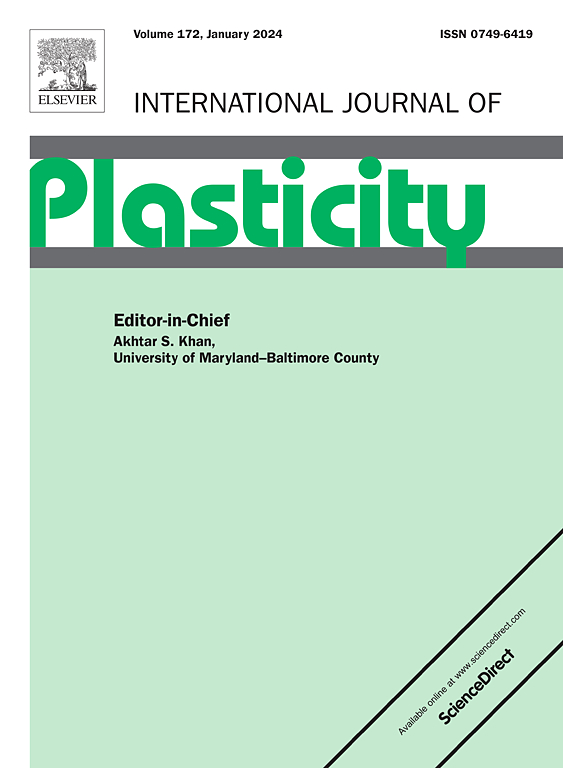A general, flexible and analytical yield criterion framework developed from a novel strategy: Gradual surface-distortion
IF 12.8
1区 材料科学
Q1 ENGINEERING, MECHANICAL
引用次数: 0
Abstract
Yield criterion with concise parameters and high accuracy has always been recommended for industrial applications. Based on a novel modeling strategy of gradual surface-distortion (GSD), an analytical yield criterion framework is constructed under the associated flow rule, integrating simplicity, generality and flexibility. Derived from structures of SY2009 criterion, R-value and curvature control terms with independent parameter calibration are developed, resulting in yield surface distortion occurring gradually. Three curvature variables are integrated into a single factor through empirical formulas without additional pure shear and plane strain tension experiments. This framework is an eighth-order homogeneous polynomial, with all parameters uniquely determined through a set of mechanical tests conducted under plane stress conditions. Initially, a simplified GSD version is constructed to characterize yield loci of BCC and FCC materials, requiring a minimum of only seven experimental data (, , , , , , ). Subsequently, by introducing stresses and R-values in two optional directions, an extended GSD version is proposed to enhance strong anisotropy description. The generality and accuracy of this framework are validated across 19 different materials to predict yield locus, uniaxial stress and R-value curves. The results demonstrate that the simplified model almost replicates Yld2000–2d and enables accurate prediction in the evolution of yield locus under anisotropic hardening. For strongly anisotropic materials, the extended model exhibits high prediction accuracy. By using an implicit finite element method, this framework accurately predicts the earing profile in cup drawing of AA3104-H19. Besides, the convexity trust-domain and the generality of curvature variables are discussed.


一种通用的、灵活的、可分析的屈服准则框架是从一种新的策略发展而来的:逐渐的表面变形
工业应用中一直推荐参数简明、精度高的良率判据。基于一种新的渐变曲面变形(GSD)建模策略,在关联流规则下构建了一个集简洁性、通用性和灵活性于一体的屈服准则分析框架。在SY2009准则结构的基础上,开发了具有独立参数标定的r值和曲率控制项,导致屈服面畸变逐渐发生。通过经验公式将三个曲率变量整合为一个单一因素,无需额外进行纯剪切和平面应变拉伸试验。该框架是一个八阶齐次多项式,所有参数都是通过在平面应力条件下进行的一组力学试验唯一确定的。最初,构建了简化的GSD版本来表征BCC和FCC材料的产率位点,至少只需要7个实验数据(T0T0, T45T45, T90T90, TEBTEB, r0r0, r45r45, r90r90)。随后,通过在两个可选方向上引入应力和r值,提出了一种扩展的GSD版本,以增强强各向异性描述。在19种不同材料上验证了该框架的通用性和准确性,以预测屈服轨迹、单轴应力和r值曲线。结果表明,简化模型与Yld2000-2d基本一致,能够准确预测各向异性硬化条件下屈服轨迹的演变。对于强各向异性材料,扩展模型具有较高的预测精度。该框架采用隐式有限元方法,准确预测了AA3104-H19杯形拉伸的耳形。此外,还讨论了曲率变量的凸性、信赖域和一般性。
本文章由计算机程序翻译,如有差异,请以英文原文为准。
求助全文
约1分钟内获得全文
求助全文
来源期刊

International Journal of Plasticity
工程技术-材料科学:综合
CiteScore
15.30
自引率
26.50%
发文量
256
审稿时长
46 days
期刊介绍:
International Journal of Plasticity aims to present original research encompassing all facets of plastic deformation, damage, and fracture behavior in both isotropic and anisotropic solids. This includes exploring the thermodynamics of plasticity and fracture, continuum theory, and macroscopic as well as microscopic phenomena.
Topics of interest span the plastic behavior of single crystals and polycrystalline metals, ceramics, rocks, soils, composites, nanocrystalline and microelectronics materials, shape memory alloys, ferroelectric ceramics, thin films, and polymers. Additionally, the journal covers plasticity aspects of failure and fracture mechanics. Contributions involving significant experimental, numerical, or theoretical advancements that enhance the understanding of the plastic behavior of solids are particularly valued. Papers addressing the modeling of finite nonlinear elastic deformation, bearing similarities to the modeling of plastic deformation, are also welcomed.
 求助内容:
求助内容: 应助结果提醒方式:
应助结果提醒方式:


